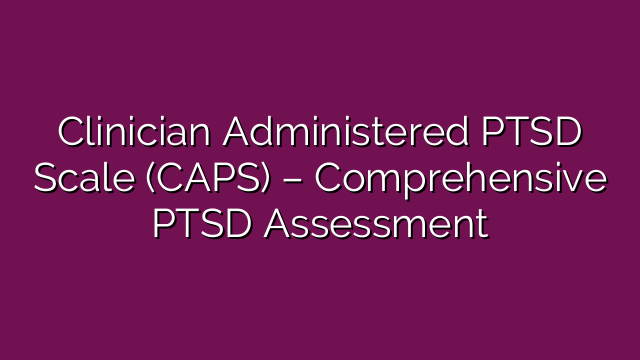Have your progress notes written for you automatically
The assessment of post-traumatic stress disorder needs good tools that help diagnose correctly and plan treatment. Without a comprehensive assessment, clinicians might miss PTSD symptoms or mix them up with other problems. Among these tools, the Clinician Administered PTSD Scale stands out as the gold standard for mental health workers. It gives a structured but flexible way to assess symptoms that works much better than simple checklists. This article will explain what CAPS is, how it works in therapy offices, what it measures, and why it matters for therapists who want to give the best care to people who have lived through trauma.
Clinician Administered PTSD Scale (CAPS) Description
The Clinician Administered PTSD Scale, updated to CAPS-5, is a 30-item structured interview that helps assess PTSD symptoms. This tool was originally created with two main purposes in mind: to help with diagnosis and to measure how severe the symptoms are.
With the CAPS, clinicians can:
- Diagnose current PTSD (based on symptoms in the past month)
- Assess lifetime PTSD
- Monitor PTSD symptoms over the past week
It’s a versatile tool that gives a detailed and reliable picture of how trauma is affecting a person, both now and over time.
Who is the Clinician Administered PTSD Scale (CAPS) Designed For?
The CAPS-5 was made for clinical professionals who understand PTSD. This includes psychiatrists, psychologists, social workers, and other mental health providers. Trained paraprofessionals can also give the assessment.
The tool works best with adult patients who have experienced trauma and show possible PTSD symptoms. The full interview takes about 45-60 minutes, so it’s better for full assessments rather than quick screenings.
For younger patients, there’s a special version called CAPS-CA-5 for children and teens ages 7 and older.
The CAPS serves two main purposes: clinical work and research. Clinicians use it to diagnose patients and plan treatment. Researchers use it to measure outcomes in studies about PTSD treatments.
History and Development of the Clinician Administered PTSD Scale (CAPS)
The CAPS began in the early 1990s. Blake, Weathers, and colleagues created the first version. They needed a standard way to diagnose PTSD that all clinicians could use the same way.
As understanding of trauma changed and diagnostic manuals updated, the Clinician Administered PTSD Scale changed too. The biggest recent update came with DSM-5, creating the CAPS-5 version by Weathers, Blake, Schnurr, Kaloupek, Marx, and Keane in 2013. Key changes in this version included focusing on one traumatic event instead of three, updating to 30 items that match DSM-5 criteria for PTSD, adding questions about the dissociative subtype, and using a single severity score instead of separate frequency and intensity scores.
More recently, the CAPS-5-R has refined the assessment with improvements to standardization, clarity, and psychometric performance. This version includes expanded prompts and scoring guidelines, a more granular 0-10 severity scale instead of 0-4, a frequency response card to help participants report symptoms, and improved formatting. These changes enhance reliability and validity while maintaining compatibility with CAPS-5 for longitudinal research.
CAPS Scoring
The CAPS has evolved in its scoring approach over time.
Earlier CAPS Version (DSM-IV)
The earlier version evaluated 17 core PTSD symptoms using 30 items, with 5 additional symptoms commonly associated with PTSD:
- Guilt about actions during trauma
- Survivor’s guilt
- Decreased environmental awareness
- Derealization (feeling things aren’t real)
- Depersonalization (feeling disconnected from oneself)
This version used two scoring methods:
- Severity scoring: Rating symptoms on a 0-4 scale for both frequency and intensity
- Symptom presence determination: Deciding if each symptom was clinically significant
For determining if a symptom was present, clinicians could use either:
- A lenient rule: Symptom counts if rated at least 1 for frequency and 2 for intensity
- A stringent rule: Symptom counts if frequency plus intensity equals 4 or higher
Total severity scores ranged from 0-136, with scores above 65 typically indicating PTSD.
Current CAPS-5 Scoring
The CAPS-5 simplified scoring by using a single severity rating for each symptom:
- 0: Absent
- 1: Mild/subthreshold
- 2: Moderate/threshold
- 3: Severe
- 4: Extreme
This streamlined approach results in a total possible score of 0-80.
For both versions, assessment covers two timeframes:
- Current symptoms (past month)
- Worst symptoms since the trauma (if current symptoms don’t meet PTSD criteria)
This simplified approach makes the CAPS-5 more efficient while maintaining its diagnostic accuracy.
Structure of the CAPS
The CAPS-5 follows a clear structure based on DSM-5 criteria. The interview starts by identifying a specific traumatic event that will be the focus of questions. This usually involves using the Life Events Checklist (LEC-5) first.
After identifying the trauma, the interview goes through these symptom groups:
1. Intrusion Symptoms (Items 1-5) These assess ways the trauma keeps coming back:
- Unwanted memories
- Nightmares
- Flashbacks
- Feeling upset when reminded of the trauma
- Physical reactions to reminders
2. Avoidance (Items 6-7) These look at how the person tries to avoid the trauma:
- Avoiding thoughts or feelings about the trauma
- Avoiding people, places, or things that bring up memories
3. Negative Changes in Thoughts and Mood (Items 8-14) These explore how thinking and emotions have changed:
- Trouble remembering parts of the trauma
- Negative beliefs about self, others, or the world
- Blaming self or others
- Ongoing negative emotions
- Less interest in activities
- Feeling distant from others
- Trouble feeling positive emotions
4. Changes in Arousal and Reactivity (Items 15-20) These assess how the person’s alertness and reactions have changed:
- Irritability and anger
- Risky behavior
- Being overly watchful
- Easily startled
- Problems concentrating
- Sleep problems
The interview also asks about when symptoms started and how they affect daily life and checks for the dissociative subtype.
How the CAPS is Administered
The CAPS-5 follows a standard process. First, the clinician explains the purpose and builds rapport. Then they identify the main traumatic event using the Life Events Checklist or direct questions.
For each symptom, the clinician asks standard questions and follows up to get details. For example, when asking about unwanted memories, they might ask:
- “In the past month, have you had any unwanted memories of the event while awake?”
- “How do these memories come to you?”
- “How much do they bother you?”
- “Can you put them out of your mind?”
- “How often do they happen?”
The interview balances structure with flexibility. The main questions stay the same, but follow-up questions can be adjusted based on answers, which helps get accurate information while being sensitive to the person’s experience.
Clinicians should be supportive but neutral when giving the assessment. They should acknowledge how hard it can be to talk about trauma while avoiding leading questions.
The CAPS-5 comes in three versions: past week, past month, and worst month (lifetime). The past-month version is most common for current diagnosis, while the lifetime version helps understand the person’s history.
What the CAPS Measures
The CAPS-5 measures several key aspects of PTSD:
- Trauma Exposure: It checks whether the person experienced or witnessed events involving death, serious injury, or sexual violence.
- Symptom Presence and Severity: For each of the 20 symptoms, it measures both if the symptom exists at a significant level and how severe it is to help identify which symptoms cause the most problems.
- Time Factors: The assessment captures when symptoms started, how long they’ve lasted, and how they’ve changed. This shows whether symptoms began right after the trauma or later and if they’ve been constant or changing.
- Effects on Life: Beyond symptoms, the CAPS-5 measures how PTSD affects relationships, work or school, and quality of life, which helps plan treatment that addresses real-life problems.
- Dissociative Subtype: The assessment checks for feeling detached from oneself or feeling that surroundings aren’t real. These experiences can require specific treatment approaches.
- Response Validity: The structure helps clinicians judge whether reported symptoms are consistent and credible.
Using CAPS in Diagnosis and Treatment Planning
The CAPS-5 does more than diagnose – it guides treatment. When used well, it provides insights that help therapists create effective treatment plans.
For diagnosis, the CAPS-5:
- Confirms PTSD based on DSM-5 criteria
- Distinguishes PTSD from similar conditions like depression or anxiety
- Identifies the dissociative subtype if present
For treatment planning, it provides valuable information:
- Shows which specific symptoms need the most attention
- Helps prioritize treatment targets based on severity
- Reveals how PTSD affects different areas of life
For example, if the assessment shows severe nightmares and hypervigilance but mild avoidance, treatment might focus first on sleep problems and reducing the constant sense of danger.
During treatment, giving the CAPS-5 again can track progress. Improved scores show what’ s working, while stubborn symptoms show what needs more attention.
The assessment also helps communicate with other providers and insurance companies, clearly showing the diagnosis and treatment needs.
Clinician Tip: Many therapists are streamlining their assesment workflow using digital tools like Mentalyc. This HIPAA-compliant platform can automatically generate treatment plans based on assessment results, saving time on documentation while ensuring your interventions directly target the specific symptom clusters identified in your assessment. It lets you spend less time on paperwork and more time focusing on therapeutic interventions.
Benefits of CAPS Over Self-Report Tools
While questionnaires are convenient, the CAPS-5 interview offers special advantages:
- Clinical Judgment: The CAPS-5 includes professional judgment in the assessment. The interviewer can tell the difference between similar but distinct problems. For example, someone might report “nightmares” on a questionnaire, but the interview might reveal they’re general bad dreams, not trauma-specific.
- Better Symptom Understanding: The interview format allows for deeper exploration. If someone reports avoiding trauma reminders, the clinician can find out exactly what they avoid and how it affects their life.
- Checking Accuracy: The clinician can assess whether symptoms are being over-reported, under-reported, or misunderstood based on the person’s behavior and consistency of answers.
- Understanding Context: The interview captures the bigger picture around symptoms – when they happen, what triggers them, and how they relate to the trauma, which helps create a more effective treatment plan.
- Building Relationship: The CAPS-5 process itself can help build trust. It shows the clinician understands trauma reactions and begins the therapeutic relationship needed for treatment.
- Better Diagnosis: The interview helps distinguish PTSD from other conditions with similar symptoms. What looks like emotional numbness on a questionnaire might actually be depression or medication effects.
Limitations and Considerations
Despite its strengths, the CAPS-5 has some limitations:
- Time Required: The biggest practical limit is time. A full CAPS-5 takes 45-60 minutes – much longer than questionnaires. This can be hard in busy clinical settings.
- Training Needs: Using the CAPS-5 properly requires training. While the format helps standardize assessment, good interpretation still needs clinical judgment and understanding of trauma.
- Patient Comfort: The intensive interview can be difficult for some trauma survivors. It might trigger distress during the assessment. Clinicians must balance thorough assessment with patient comfort.
- Cultural Factors: While the CAPS-5 works well across different populations, some trauma responses might be culturally specific and not fully captured. Clinicians should stay aware of cultural differences in how trauma is expressed.
- Focus on PTSD Only: Focusing only on PTSD symptoms might miss other important issues. The CAPS-5 should be part of a broader assessment.
- Practical Challenges: Implementation challenges include ensuring consistent use across clinicians, recording results in medical records, and establishing protocols for repeated assessments.
Despite these limitations, the CAPS-5 remains invaluable when used appropriately. By understanding both its strengths and limitations, clinicians can make good decisions about when and how to use this assessment.
A Powerful Tool for Trauma Healing
The CAPS-5 is not just a way to diagnose PTSD—it is a tool that really helps you understand what someone’s going through. It can provide a clearer picture of the person in front of you, not just a checklist of symptoms.
It’s true that it takes some time to learn, but it’s worth it. Once you get the hang of it, it helps make more accurate diagnoses, track changes over time, and really see how someone is doing.
For those of us who work with trauma, the CAPS-5 helps turn painful experiences into something we can actually work with. It helps us see where the person is struggling the most so we can support them better.
No tool is perfect, and trauma is incredibly complex—but the CAPS-5 gets pretty close. It gives us and our clients a clearer path from pain to recovery, and that makes a real difference.










